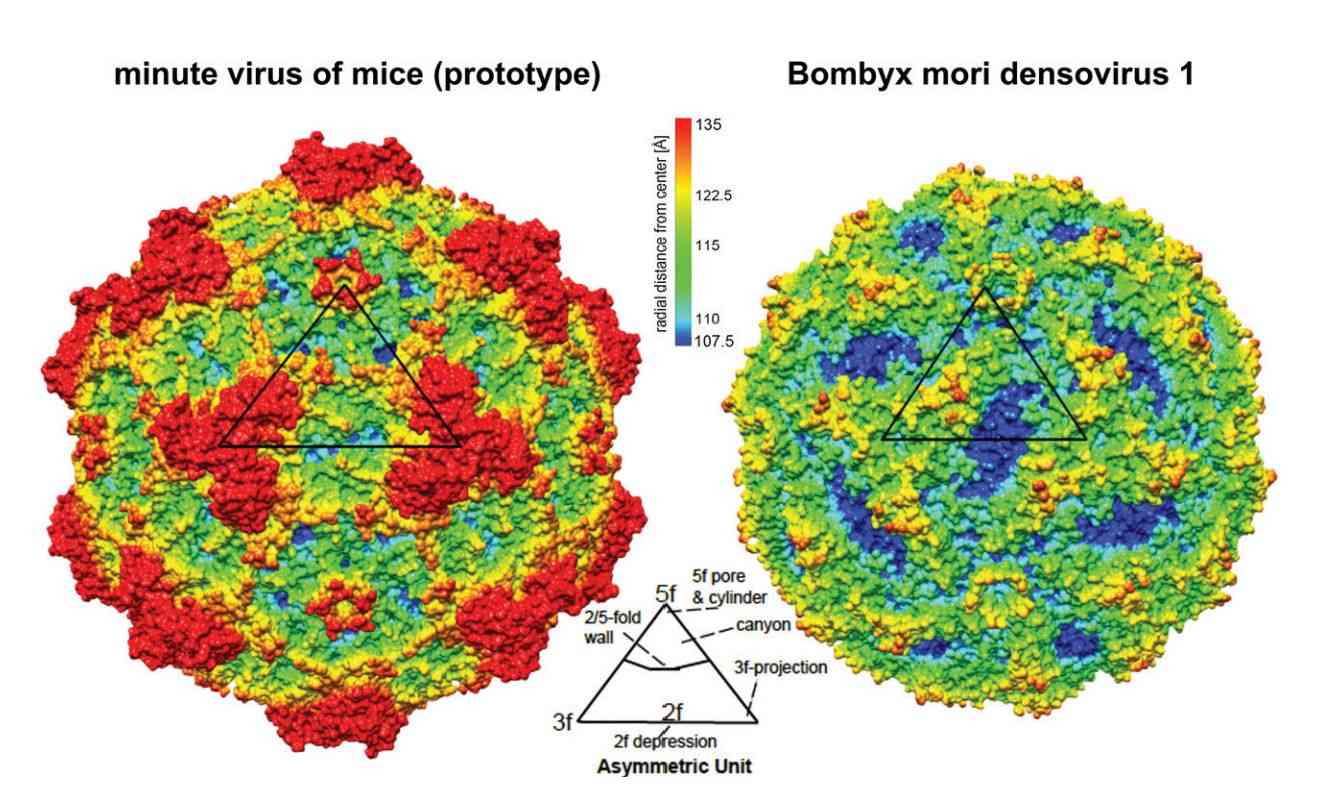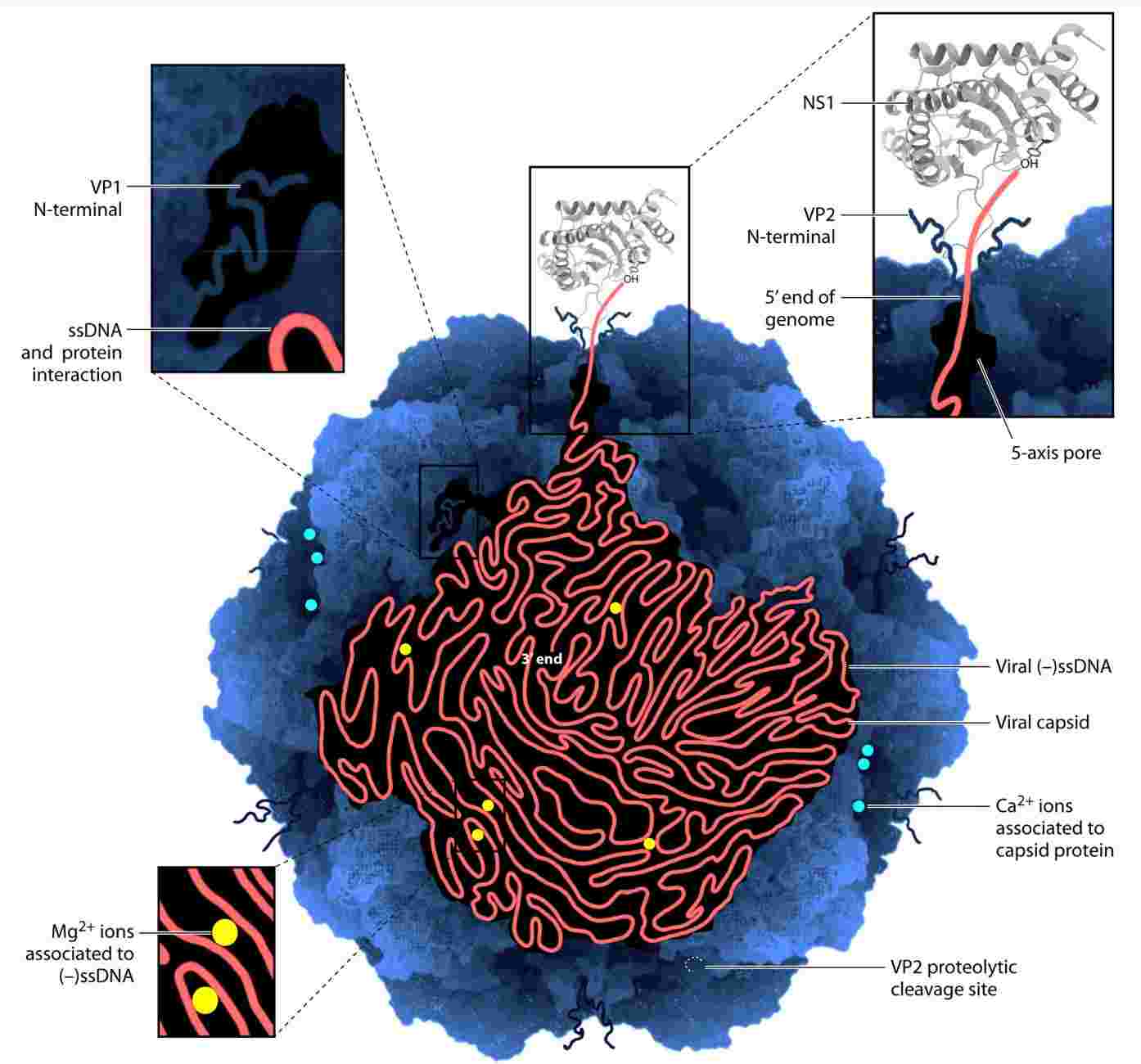Structural Research of Parvoviridae
The Parvoviridae are a group of small, resilient, enveloped viruses with linear single-stranded DNA (ssDNA) genomes, including the vertebrate-infecting Parvovirinae and the invertebrate-infecting Densovirinae. Members of the family typically contain two genes encoding a replication initiation protein NS1 and a viral capsid protein. Most parvovirus is host- or tissue-specific, and some cause fatal diseases in animals. Recent research has found that parvovirus has a significant impact on cancer therapy and genetic engineering applications. Therefore, research on the invasion pathways of parvovirus based on structural studies is essential in gene therapy, cancer therapy, vaccine development, and passive immunization vectors.
 Figure 1. Three-dimensional X-ray diffraction structure of a mini-virus parvovirus. (Cotmore SF, et al, 2019)
Figure 1. Three-dimensional X-ray diffraction structure of a mini-virus parvovirus. (Cotmore SF, et al, 2019)
Analysis of the Genome Structure of Parvoviridae
Members of the Parvoviridae family have a linear, single-part ssDNA genome of 4-6kb, flanked by partial double strands consisting of imperfect palindromes folded into a hairpin loop structure to form an Inverted Terminal Repeat (ITR) sequence. This family typically contains two genes: NS/rep and VP/cap. NS encodes the nonstructural protein NS1, and VP encodes the viral proteins (VP) that make up the viral capsid. These are usually N-terminal extensions of each other, share overlapping C-terminal segments, and are assembled into the capsid. The unique N-terminal extension of the largest para-capsid protein 1 (VP1u) typically encodes the highly conserved phospholipase A2 (PLA2) structural domain, which is essential for viral invasion.
Advances in Structural Research on Parvovirus
In 1990, the first atomic structure of the canine parvovirus (CPV) capsid revealed a 26 nm diameter T=1 particle. With advances in three-dimensional image reconstruction and cryo-electron microscopy (cryo-EM), knowledge of the structure and function of parvovirus particles has increased, and the capsid structures of the majority of the Parvoviridae group have now been determined. Parvoviruses have small uncoated capsids, 200 to 280 Å in diameter, and typically contain 50 to 55 copies of a smaller capsid protein, VP2, and 5 to 10 copies of a larger capsid protein, VP1, which has an additional N-terminal peptide sequence. The structural topology of all parvovirus capsids is conserved, but the conformation of the surface loops inserted between the core secondary structure elements varies.
 Figure 2. Model of the structural features in the parvovirus capsid. (López-Astacio RA, et al, 2023)
Figure 2. Model of the structural features in the parvovirus capsid. (López-Astacio RA, et al, 2023)
Creative Biostructure offers a wide range of virus-like particles (VLPs) products generated from recombinant E. coli, yeast, insect cells, or HEK293 cells for the discovery and characterization of whole drugs and antibodies, and have been integrated into a variety of platforms including basic research on the viral structure, vaccine discovery, and drug delivery systems.
| Cat No. | Product Name | Virus Name | Source | Composition |
| CBS-V930 | Parvovirus B19 VLP (VP1) | Parvovirus B19 | E. coli recombinant | VP1 |
| CBS-V087 | Parvovirus B19 VLP (VP2) | Parvovirus B19 | Insect cell recombinant | VP2 |
| CBS-V562 | Canine parvovirus virus VLP (VP2 Proteins) | Canine parvovirus | Insect cell recombinant | VP2 |
| CBS-V589 | Human bocavirus VLP (VP2 Proteins) | Human bocavirus | Insect cell recombinant | VP2 |
| Explore All Parvoviridae Virus-like Particle Products | ||||
As an expert in structural biology, Creative Biostructure can provide services for structural research on Parvoviridae family members, including sample preparation and cryo-electron microscopy (cryo-EM) analysis. With cutting-edge equipment and a professional team, we are committed to providing clients with high-quality research services in viral structural biology.
If you are interested in exploring the structure of parvovirus and would like to find out more about the services we offer, please contact us. Our team is always available to discuss your research requirements and provide you with the most effective solution for your project.
References
- Cotmore SF, et al. ICTV Virus Taxonomy Profile: Parvoviridae. J Gen Virol. 2019. 100(3): 367-368.
- López-Astacio RA, et al. The Structures and Functions of Parvovirus Capsids and Missing Pieces: the Viral DNA and Its Packaging, Asymmetrical Features, Nonprotein Components, and Receptor or Antibody Binding and Interactions. J Virol. 2023. 97(7): e0016123.
- Shi J, et al. Progress in the study of parvovirus entry pathway. Virol J. 2023. 20(1): 61.
- Mietzsch M, et al. Twenty-Five Years of Structural Parvovirology. Viruses. 2019. 11(4): 362.